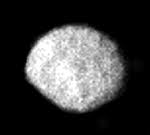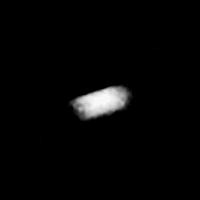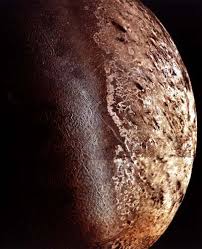By Kevin Kearney and Mike DeLeo
Overview
Neptune has 13 moons that are known to man and are composed of rock and ice. There are 4 inner moons names Naiad, Thallasa, Despina, and Galatea whose orbits are on the same orbit as Neptune's rings. The next moon out is named Larissa. this moon was discovered in 1981 but was thought to be the ring arcs of Neptune. Later it was rediscovered by the Voyager 2 in 1989. Proteus is the second largest moon that orbits Neptune. This moon is so close to Neptune however that it is not visible by telescopes that are on Earth. Triton is the largest moon of Neptune and is one of the strangest moons in the solar system. First it is one of only three moons in the solar system that actually has an atmosphere. It also has a retrograde orbit, meaning that it orbits theopposite way that the planet rotates. There are two theories about how Triton was captured and became a moon of Neptune. The first theory is that Triton collided with Neptune, bounced off of the atmosphere, and went into orbit because it lost all of its momentum. The other theory is that Triton collided with one of Neptune's moons, smashed the moon into bits (possibly creating the rings), and lost so much momentum that it couldnt escape Neptune's gravity. Another strange thing about Triton is that it has geysers that spray out a form of nitrogen that actually creates the atmosphere. Triton is slowly spiraling towards Neptune and could one day collide with it. The eight moon of Neptune is Nereid. This moon has a highly ecliptic orbit that causes it to swing around Neptune at various distances. When it is closest to Neptune it is 1,342,530 km's from Neptune. When it is farthest it is 9,667,120 km's from Neptune. The last 5 moons are named Halimede, Sao, Laomedeia, Psamathe, and Neso. These 5 moons were discovered between 2001 and 2003 and there is very little known about these moons.
(Thallassa) (Despina) (Larissa)



(Naiad) (Galatea) (Triton) (Nereid)




|
|
|
|
|
|
|
|
| Naiad (NIII) |
1989 |
Voyager 2 |
48.227 |
0.002 |
29 |
0.294 |
| Thalassa (NIV) |
1989 |
Voyager 2 |
50.075 |
0.0004 |
40 |
0.311 |
| Despina (NV) |
1989 |
Voyager 2 |
52.526 |
0.02 |
74 |
0.335 |
| Galatea (NVI) |
1989 |
Voyager 2 |
61.953 |
0.04 |
79 |
0.429 |
| Larissa (NVII) |
1989 |
Voyager 2 |
73.548 |
0.05 |
104x89 |
0.555 |
| Proteus (NVIII) |
1989 |
Voyager 2 |
117.647 |
0.5 |
218x208x201 |
1.122 |
| Triton (NI) |
1846 |
W. Lassel |
354.76 |
214 |
1353.4 |
5.877* |
| Nereid (NII) |
1949 |
G. Kuiper |
5513.4 |
0.3 |
170 |
360.136 |
| S/2002 N1 |
2002 |
|
15,686 |
0.001 |
24 |
1874.8 |
| S/2002 N2 |
2002 |
|
22,452 |
0.001 |
24 |
2918.9 |
| S/2002 N3 |
2002 |
|
22,580 |
0.001 |
24 |
29.82 |
| S/2002 N4 |
2002 |
|
46,570 |
|
30 |
8863.1* |
| S/2003 N1 |
2003 |
|
46,738 |
0.0002 |
14 |
9136.1* |
The Voyager 2 was the first spacecraft to observe the planet neptune. The Voyager visited Neptune on August 25th 1989. It discovered 6 of Neptunes 13 moons. This was the latest research that was conducted to find out information about Neptune.
Experiments
We would send landers to Neptune in order to gather information such as atmospheric components and compounds found on the planet. We would send these landers to Triton the largest moon of Neptune near its geysers in order to find out as much information as possible. We would also send probes to try to gain information on the moon such as what makes up its atmosphere. If we could find out alot of information about Neptune and its moons, it could help us to solve the mystery about how the planets were formed. It is believed that Triton is not formed from material that comes from Neptune ,but that it has come from the Kuiper Belt. These experiments would enable us to learn whether this is true and whether the Kuiper belt plays a large role in the formation of the solar system.
Making Experiments Work
In order to make these experiments work it would require alot of money. We would have to send the landers on a chemical rocket to get it out of Earth's orbit. Then we would use another propulsion unit , like a modified submarine unit that is propelled by a small nuclear fission reactor to propel the landers to Triton. This type of propulsion would work by using electrically charged ions to work the engine. We would need to have advanced landers to be able to survive the extremely cold conditions of the moon and gather information that could be sent back to Earth. With the new information gained from our experiments we could answer questions such as how the solar system was created and if Triton came from Neptune or the Kuiper belt.
Credits for pictures and charts:
http://burro.astr.cwru.edu/stu/neptune_moons.html
http://images.google.com/imgres?imgurl=http://apod.nasa.gov/apod/image/9910/triton2_vg2.jpg&imgrefurl=http://apod.nasa.gov/apod/ap991010.html&usg=__A4h21kJBLFcxF17YMYIW60Lgovo=&h=493&w=400&sz=40&hl=en&start=6&um=1&tbnid=GMTR0c0-W4NeqM:&tbnh=130&tbnw=105&prev=/images%3Fq%3Dtriton%2Bmoon%26um%3D1%26hl%3Den
http://www.zgapa.pl/zgapedia/data_pictures/_uploads_wiki/g/Galatea_moon.jpg
http://www.redorbit.com/modules/reflib/article_images/4_388a4d899691edfba24bcfba0046b1e3.jpg
http://www.redorbit.com/modules/reflib/article_images/4_aecd54f7ea1613354701b26609de76bd.jpg
http://apod.nasa.gov/apod/image/proteus_vg2.gif
http://solarsystem.nasa.gov/planets/images/inset-nep_larissa.gif
Comments (3)
James McCarrick said
at 1:43 pm on Jan 10, 2009
Great experiments all of them are possible giving it a big plus, I also found it really interesting that the moons are named after the daughters of the roman god Neptune. Maybe if you had more info on some of the other moons other than Triton it would have been better but I know that hard since there is very little information about them so great Job on the project.
Dave Goldberg said
at 5:41 pm on Jan 6, 2009
Totally awesome dude!! The experiments were pretty thorough and I liked the nuclear propulsion system to get to the moons. Good job you get an A
Luka Novak said
at 4:50 pm on Jan 4, 2009
Your experiments are great. You thought about everything. The only thing I could add is to maybe try to solve some more mysteries of Neptunes other moons besides Triton.
You don't have permission to comment on this page.